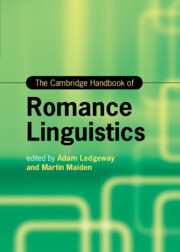Book contents
- The Cambridge Handbook of Romance Linguistics
- Cambridge Handbooks in Language and Linguistics
- The Cambridge Handbook of Romance Linguistics
- Copyright page
- Dedication
- Contents
- Figures
- Tables
- Contributors
- Abbreviations
- 1 Data, Theory, and Explanation: The View from Romance
- Part One What Is a Language?
- Part Two Phonetics and Phonology
- Part Three Morphology
- Part Four Syntax
- 16 Argument Structure and Argument Realization
- 17 Agreement
- 18 Alignment
- 19 Complex Predicates
- 20 Dependency, Licensing, and the Nature of Grammatical Relations
- 21 Parametric Variation
- Part Five Semantics and Pragmatics
- Part Six Language, Society, and the Individual
- Index
- References
20 - Dependency, Licensing, and the Nature of Grammatical Relations
from Part Four - Syntax
Published online by Cambridge University Press: 23 June 2022
- The Cambridge Handbook of Romance Linguistics
- Cambridge Handbooks in Language and Linguistics
- The Cambridge Handbook of Romance Linguistics
- Copyright page
- Dedication
- Contents
- Figures
- Tables
- Contributors
- Abbreviations
- 1 Data, Theory, and Explanation: The View from Romance
- Part One What Is a Language?
- Part Two Phonetics and Phonology
- Part Three Morphology
- Part Four Syntax
- 16 Argument Structure and Argument Realization
- 17 Agreement
- 18 Alignment
- 19 Complex Predicates
- 20 Dependency, Licensing, and the Nature of Grammatical Relations
- 21 Parametric Variation
- Part Five Semantics and Pragmatics
- Part Six Language, Society, and the Individual
- Index
- References
Summary
In this chapter, we discuss three classes of phenomena that are captured by the terms dependency and licensing, in clauses and nominal expressions: (i) the structural relation between a lexical head (e.g., V, N, A) and the functional structure projected by it such as the relation between a verb and an auxiliary or between a noun and a determiner; (ii) the selectional relation between a lexical head and the constituents that are combined with it to satisfy its argument structure, as in the case of the verb and the direct object; and (iii) the structural relation created by two different constituents that share the same referential index. In the third case, we observe two major types: a constituent is displaced, as in the case of the subject of a passive clause or a wh-constituent; or two constituents share the same referent but have different functions in the clause (or in different clauses), as is the case of pronouns and their antecedents. The dependencies dealt with in the first two cases are ‘local’, while the others can be long distance. Most of the analyses of the dependency phenomena relate the relative richness in inflexional morphology to variation in word order, argument marking, agreement, and the realization of pronominal reference.
Keywords
- Type
- Chapter
- Information
- The Cambridge Handbook of Romance Linguistics , pp. 604 - 636Publisher: Cambridge University PressPrint publication year: 2022



